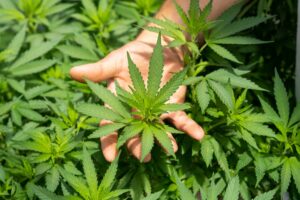Terpenes, also known as terpenoids, are the scent stars of the plant world. While there are tens of thousands of terpenes in nature, not a lot of people know what they are, and fewer understand why they’re important.
Terpenes play a significant role in the effects herbs take, and many plants share terpenes in common, creating synergistic opportunities when used in combination. Discerning between different scent notes in your herbs can also help you figure out what a certain plant will do.
Let’s examine how terpenes work and explore tips for maximizing their impacts. Some of the terpenes occurring in cannabis and hemp are likely present in plants you may already have in your at-home apothecary. For instance, did you know that mangoes and certain cannabis strains share terpenes in common? Read on for pairings and pointers.
What are Terpenes?
Terpenes are responsible for the way a plant smells. While contributing to a host of aromatherapeutic effects, scent also serves different survival functions in plants. By emitting specific aromas, plants can ensure they have plenty of legroom by warding off pests, predators, and even other plants. They can also help themselves proliferate by attracting desired interactions, such as with pollinators.
You can find terpenes in everything that grows from the ground—fruits, vegetables, spices, you name it. With over 30,000 identified types, they are the most common phytochemicals around. In cannabis, terpenes are located on the flower’s trichomes, which is why the scent lingers on your hands after touching it.
How do Terpenes Work?
The “entourage effect” is the synergistic reaction between terpenes, cannabinoids, and other plant compounds in cannabis and hemp that produces certain pharmacological reactions. Cannabis boasts about 100 terpenes across the board, which interact with phytocannabinoids to enhance or diminish the effects you feel when you ingest it.
For example, a terpene called pinene in certain cannabis strains can combat the short-term memory impairment caused by THC. Pinene is abundant in—you guessed it—pine trees, and functions as an anti-inflammatory and bronchodilator.
Limonene, the terpene found in the skin of citrus fruit, is the second most abundant terpene in cannabis and is responsible for its stimulating, mood-elevating effects. Limonene has also been shown to boast anti-depressant characteristics (think the uplifting effect of citrus oils in aromatherapy).
Like cannabinoids, terpenes degrade during the decarboxylation process, but not completely. Smoking will reduce the number of terpenes, but that doesn’t necessarily mean you’re getting less exposure to them if you smoke. Since inhalation carries them directly into your bloodstream, it’s still the fastest (and a very potent) method of administration. That partially explains why it’s the method favored by most medical patients with previous recreational cannabis and hemp experience.
Extraction can also minimize or eliminate terpenes from flower. Some companies actually extract terpenes from other plants (such as lavender or citrus fruit) and reintroduce them to their products to create something closer to whole-plant medicine, which is more competitive on the market.
How to Use Terpenes
Take it from Neil Young: synergy is key. In a 2019 interview with Howard Stern, Young suggested that anyone who was feeling paranoid from cannabis use should chew on a few black peppercorns. Black peppercorn is high in the terpene alpha-pinene, which mitigates the effects of overdoing it on THC. Thanks for the tip, Uncle Neil!
You can also supplement your medicine with terpenes that enhance what you’re feeling. Mango has a terpene called myrcene, which is often found in concentrated percentages in indica strains. Eating mango an hour before consuming one of these cannabis varieties will prolong its felt effects. A muscle relaxant and sedative, myrcene is also dominant in hops. That explains why a cup of hops tea constitutes a lights-out for some folks.
Terpenes don’t just affect mood or memory. The Zingiberaceae family (ginger, turmeric) is chock-full of terpenes that contribute to antiulcer, anticancer, and antioxidant properties.
What are the Benefits of Terpenes?
Anti-inflammation is the most obvious choice here, but there are others. Whether a certain effect is beneficial or not depends on what you’re trying to do. Some terpenes stimulate, others sedate, so knowing a little about the terpene profiles in your cannabis or hemp will help you decide which strain to choose for which purpose.
How do you find the terpene profile? Consulting your cultivator or budtender is a good place to start, but it’s not necessary. The nose knows, friends. Give your plant a big whiff and notice what you’re smelling. Citrus? That’s limonene. Does it smell a little like a Christmas tree? That’s pinene for you. Getting a grassy, floral note, similar to that in lavender? That would be linalool which has lavender’s characteristic sedative and analgesic effects.
Just be careful not to let your flower (or other herbs) dry out completely, or the terpenes will evaporate. Terpenes are abundant in a plant’s volatile oils (hence the use of essential oils in aromatherapy) and are lost for good when the plant is fully dry. That means that unless you store your herbs in airtight containers, they’ll degrade and eventually disappear. Reintroducing water to overly dry herbs in an attempt to reinvigorate them is a no-go. Once they’re gone, they’re gone. As anyone who’s ever tried to give new life to old flower will attest, rehydration is not a thing.


I love this so much! Thank you! And by the way, Neil is my pretend-boyfriend ☺️
Glad you approve!